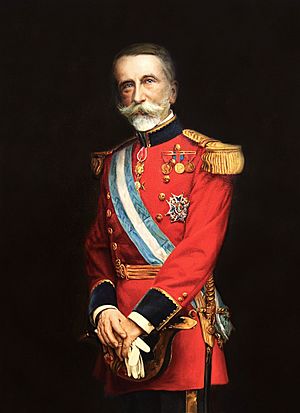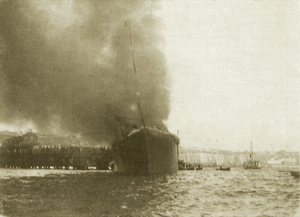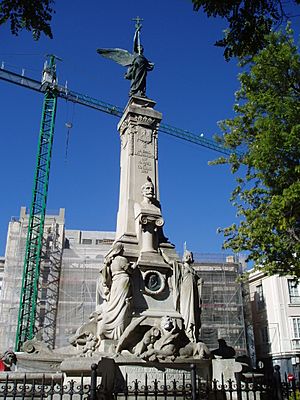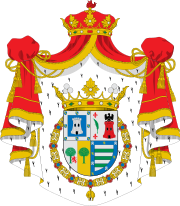Claudio López, 2nd Marquess of Comillas facts for kids
Quick facts for kids
The Most Excellent
The Marquess of Comillas
|
|
|---|---|

Oil on canvas, by Francisco Godoy
|
|
| Personal details | |
| Born | 14 May 1853 Barcelona |
| Died | 18 April 1925 (aged 71) Madrid |
| Nationality | Spanish |
| Spouse | María Gayón Barrie |
Claudio López y Bru, 2nd Marquess of Comillas (born in Barcelona in 1853 – died in Madrid in 1925), was a Spanish nobleman and a very wealthy businessman. He was known as a shipping expert and a big landowner. He took over many companies that his father, Antonio López y López, had started.
For about 30 years, from 1895 to 1925, the Marquess of Comillas was very important in shaping how the Catholic Church dealt with workers' rights.
He also helped the famous architect Antoni Gaudí travel to Tangier and Tétouan in 1892. Gaudí got ideas there for a big church project that was never built. However, these ideas later inspired Gaudí's most famous work, the Sagrada Família in Barcelona.
Contents
Biography
Claudio Lopez Bru was the fourth son of Antonio López y López. His father founded and owned big companies like Compañía Transatlántica Española (a shipping company) and Compañía General de Tabacos de Filipinas (a tobacco company). His mother was Lluïsa Bru i Lassús from Catalonia.
Claudio studied law at the Universitat de Barcelona. In 1883, when his father passed away, he inherited the title "Marquess of Comillas". He was only in his early thirties. He took charge of all the companies his father had built. The most important ones were Compañia General de Tabacos de Filipinas and Ferrocarriles del Norte (a railway company).
In the years that followed, Claudio made his family's business even bigger. He added a coal company called Hullera Española, a bank called Banca López Bru, a construction company called Constructora Naval, and another bank, Banco Vitalicio.
He also helped develop the Pontifical Seminary of Comillas in Cantabria. His father had started funding this project. The first building opened in 1890. Later, the Vatican officially made it the Pontifical University of Comillas.
In 1893, a ship called Cabo Machichaco exploded in the harbor of Santander. This ship did not belong to Claudio's company. The explosion was so powerful that a heavy rope from the ship flew 8 kilometers away, killing a person. The Santander harbor was destroyed, and about 500 people died.
As soon as Claudio heard the news, he went to Santander. He sent a train from Barcelona filled with doctors, nurses, firefighters, and medical supplies. This helped thousands of injured people.
After this, Claudio refused any awards or honors from the authorities. He simply said he had only done his duty as a Christian.
He acted similarly after the 1908 Messina earthquake in Italy. This earthquake caused tens of thousands of deaths. Claudio quickly turned one of his ships, the "Cataluña," into a hospital. He sent it right away to help the victims.
A process to make him a saint, called beatification, began in 1945.
Helping Workers
Claudio López y Bru was a strong Catholic. He wanted his employees to be religious and to avoid radical worker groups. He was a very important person in the National Council of Catholic Worker Corporations (CNCCO). This group was like a business branch of Catholic Action, which was a Catholic organization.
Some people criticized his strong views. They felt he focused too much on workers' duties and not enough on the responsibilities of business owners.
Claudio played a big role in deciding how the Catholic Church dealt with workers. Under his influence, a Catholic Action section for workers was created in 1894. Later, sections for women (1919) and youth (1924) were also formed. These groups were closely controlled by church leaders and wealthy people like Claudio.
Catholic Action at this time was more about big events than strong worker groups. Claudio paid for impressive trips for working men to holy places in Spain and other countries.
He was impressed by a Catholic railway workers' group that helped stop railway strikes in 1916 and a general strike in 1917. Because of this, he tried to create similar Catholic groups for miners, especially in the Asturian coal mines, where he owned some pits.
Claudio also had a lot of influence in the Popular Social Action (ASP) group. This group was started by a Jesuit priest, Gabriel Palau, in Barcelona in 1907. Palau wanted Barcelona to be a center for Catholic social projects. Claudio helped fund the ASP.
The worker groups connected to the ASP were called Professional Unions. These unions were known for being very traditional and helping to break strikes. Claudio disagreed with some other Catholic leaders who believed workers should always get fair wages, not just enough to survive. He felt their ideas would cost business owners too much money.
Arms
- Heraldry of Claudio López, 2nd Marquess of Comillas
See also
 In Spanish: Claudio López Bru para niños
In Spanish: Claudio López Bru para niños
- Compañía Transatlántica Española
- Antonio Lopez (shipwreck)





